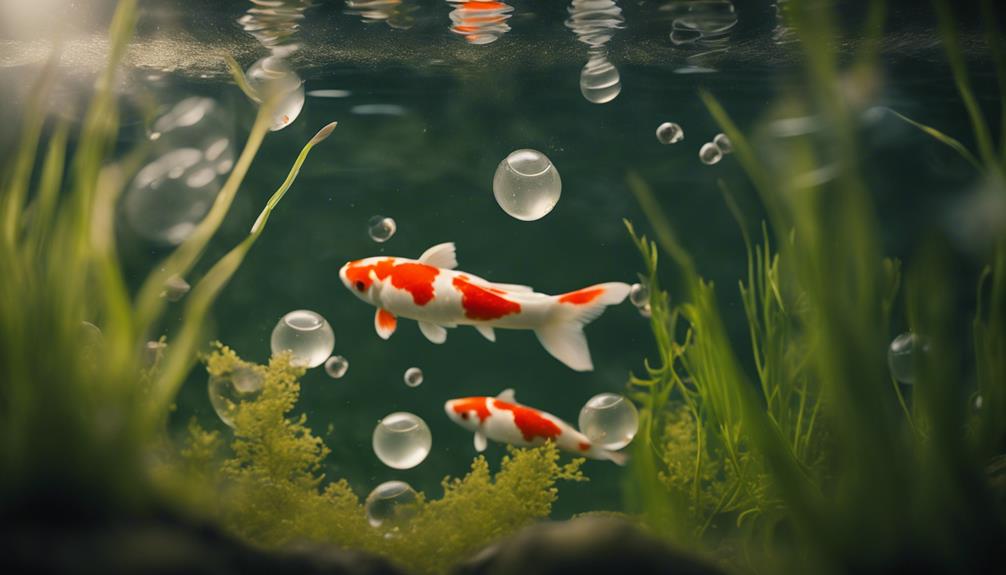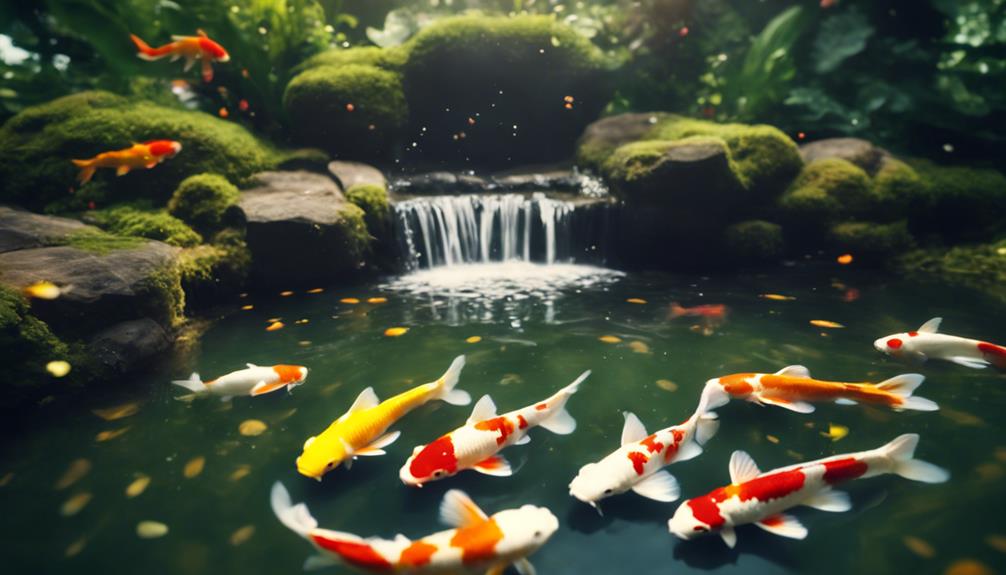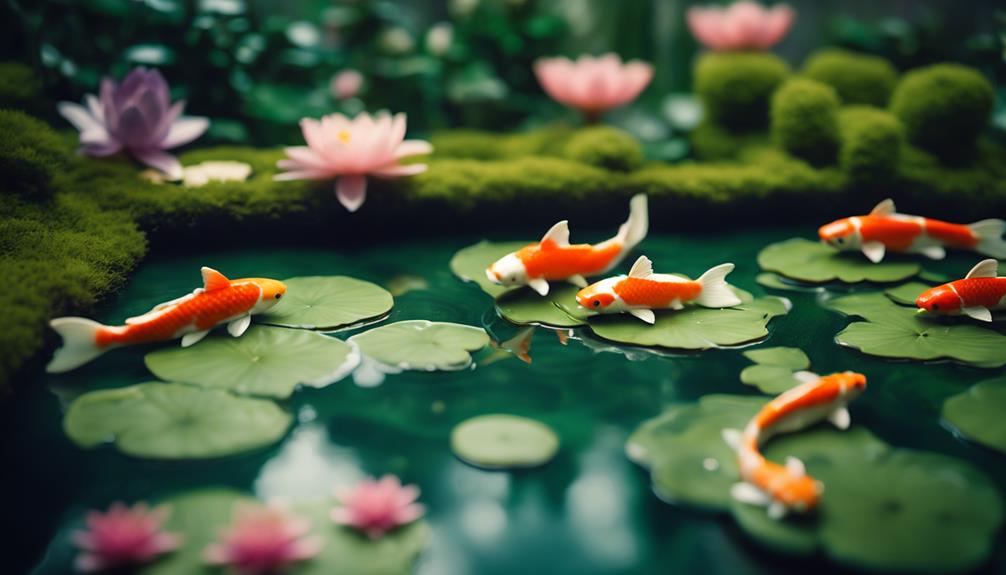You can successfully breed koi fish in small spaces by creating a dedicated breeding tank with an exhaustive system, including heating, filtering, and pumping. Choose koi that are at least 3 years old, as they're sexually mature and can produce healthy offspring. Remove predators and debris, and cover the pond with netting to safeguard your koi. Maintain superior water quality by performing regular water tests and changes. By following these steps, you'll be well on your way to breeding koi fish in small spaces. Now, get ready to dive deeper into the specifics of koi mating, spawning, and fry care to guarantee a thriving breeding environment.
Table of Contents
Key Takeaways
- Set up a dedicated breeding tank with a comprehensive system, including heating, filtering, and pumping, to ensure superior water quality.
- Remove predators and debris from the pond, and cover it with netting to safeguard koi from predators during the breeding process.
- Choose koi that are at least 3 years old, as they are sexually mature and can produce healthy offspring, and provide a safe environment during mating and spawning.
- Regularly test and maintain optimal water chemistry, performing 10-20% water changes weekly, to support the growth of eggs and fry.
- Devote time and attention to overcome obstacles, separate eggs and babies from adult koi, and maintain a clean and secure environment to ensure successful breeding.
Preparing for Breeding Success
To set yourself up for breeding success, start by preparing a dedicated breeding tank with an exhaustive system that includes heating, filtering, and pumping, as well as a clean pond environment that's free from predators and debris.
This means investing in a specialized koi pond biofiltration system to maintain superior water quality. Remove any predators and trash from the pond using a skimmer net or comparable scoop equipment, and cover the pond with netting to safeguard your koi from cats, birds, and other predators.
When selecting koi to breed, choose males and females that are at least 3 years old, as they're sexually mature and can produce healthy offspring.
Look for koi with desirable characteristics such as healthy scales, fin shape, and color. Feed your koi four times a day with protein-rich foods to support their bodies during breeding.
Provide a fry mat in the pond for your koi to lay their eggs, increasing the chances of successful breeding. Finally, guarantee the water quality is ideal for breeding, with a temperature of 68°F, and monitor water chemistry, making adjustments as necessary to support the growth of young koi.
The Koi Mating and Spawning Process
With your breeding tank and koi preparations in place, you're now ready to witness the fascinating process of koi mating and spawning.
This typically occurs when water temperatures are between 65°F and 70°F, usually in late spring or early summer between May and June.
During courtship, males will begin to chase females, nudging their sides with their mouths and fins to encourage egg-laying. Once the female is ready, she'll lay her eggs, which will then be fertilized by the males.
Vital to provide a safe and clean environment to reduce stress and promote healthy development during this process. You may notice cloudy or foamy water with a distinct odor, which is normal.
However, key to maintain good water quality to prevent disease and promote healthy growth. Make sure to prioritize proper filtration, regular water changes, and adequate oxygen levels to support the health and development of your koi fish.
Caring for Koi Eggs and Fry

As you wait for the koi eggs to hatch, prepare a safe and nutritious environment by removing the adult koi from the breeding tank and ensuring the filter system is functioning perfectly.
This vital step prevents the adults from devouring the eggs and gives the fertilized eggs a chance to hatch into healthy koi fry.
Within 3 to 6 days, the eggs will start to hatch, and you'll need to provide ideal water quality for the fry to thrive.
Monitor the water chemistry closely, maintaining zero ammonia levels and making regular water changes as necessary.
Discard any unfertilized eggs, which typically appear whitish and fuzzy, to prevent them from contaminating the water.
Once the fry are free-swimming, introduce live foods like mosquito larvae and worms to support their growth.
Remember, a good filtration system is essential for maintaining water quality and handling the added ammonia and nitrates produced by the fry.
Maintaining a Healthy Breeding Environment
You'll need to perform regular water tests to guarantee the breeding environment remains stable and healthy, monitoring parameters like pH, ammonia, nitrite, and nitrate levels.
This will help you identify any potential issues before they affect your koi's health.
To keep the water clean and safe for your fish, you'll need to perform regular water changes, ideally 10-20% every week.
This will also help maintain a balanced ecosystem in your water garden.
As your larger koi grow, they'll produce more waste, so it's vital to increase the frequency of water changes.
You should also consider upgrading your filtration system to handle the increased bioload.
A successful koi breeder knows that a healthy breeding environment is vital to producing successful koi.
By maintaining a stable and clean environment, you'll be able to breed koi that thrive and grow.
Overcoming Breeding Challenges

Breeding koi fish can be a complex and delicate process, and novice breeders often encounter several challenges that must be addressed to guarantee successful spawning and healthy offspring.
You'll need to devote a significant amount of time and attention to overcome these obstacles, making breeding koi a full-time job.
One of the biggest challenges is ensuring the survival of eggs and babies. Adult koi will eat them, so you'll need to separate them to prevent this.
In early summer, when koi are ready to lay their eggs, you'll need to provide a safe and secure environment. This means using a thick plastic sheet to prevent damage to your fish tank or breeding pool, and covering it with a net or mesh to keep predators out.
Regular cleaning and maintenance are also vital to prevent moss and algae growth.
Don't be discouraged by these challenges – with careful planning and attention to detail, you can overcome them and successfully breed koi fish in small spaces.
Frequently Asked Questions
Do Koi Fish Like Small Spaces?
When you provide a small space, you'll notice koi fish adapt by establishing territories, traversing water currents, and displaying unique behavior patterns, highlighting the importance of understanding their space requirements to guarantee their comfort and well-being.
Why Won't My Koi Breed?
You're wondering why your koi won't breed? It's likely due to poor water quality, inadequate nutrition, genetic issues, or incorrect sexing – common obstacles that hinder successful breeding, but can be overcome with proper care and attention.
How to Breed Small Koi Fish?
You'll successfully breed small koi fish by focusing on genetic selection, manipulating breeding cycles, and maintaining ideal water quality, while supplementing their diet with protein-rich food to support healthy reproduction and growth.
How to Know if a Koi Is Ready to Breed?
As you gaze into your koi's eyes, ask yourself: Are they ready to breed? Look for koi maturity signs like size, age, and genetic indicators, as well as breeding triggers like seasonal changes, to determine spawning readiness.
Conclusion
You've successfully navigated the world of breeding koi fish in small spaces!
As you celebrate your new school of vibrant fish, remember that koi breeding is a thriving industry – in fact, did you know that over 97% of koi sold worldwide are bred in small spaces, just like yours?
This staggering statistic highlights the feasibility and potential of small-scale koi breeding.
By following these guidelines, you've set yourself up for success and can now enjoy the rewards of raising these stunning fish in even the most compact environments.

